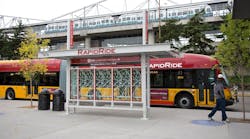OP-ED: PANYNJ’s $10 billion new midtown Manhattan Bus Terminal still short $6.5 billion
Even with the Federal Transit Administration (FTA) issuing a positive finding in completion of the National Environmental Policy Act Environmental Impact Statement, the $10 billion dollar funding package to pay for the new Port Authority of New York and New Jersey (PANYNJ) midtown Manhattan Bus Terminal is still short $6.5 billion.
The approved PANYNJ 2017 - 2026 10-year $32 billion Capital Plan provided only $3.5 billion toward construction. The project has still yet to obtain permission for admission into the FTA Capital Investment Grant (CIG) New Starts Core Capacity Full Funding Grant Agreement (FFGA) national competitive discretionary grant program. It was not included in the FTA March 2024 report to Congress for funding in 2025.
It is wishful thinking that the PANYNJ can count on future federal funding to make up most of the $6.5 billion current shortfall. Ditto for Payments in Lieu of Taxes (PILOT's) from developers for the proposed projects high rise office towers. New York Gov. Kathy Hochul's $8 billion Penn Station project, just seven blocks south, is also counting on PILOT's as a major funding source. Both projects will be competing for the same developers and tenants in a soft Manhattan office building real estate market.
You may have to wait until the next PANYNJ 10-year 2027 - 2036 Capital Plan before a complete $10 billion funding package is in place. No one can predict the final cost and completion date for the new bus terminal.
The promise by PANYNJ Executive Director Rick Cotton that electric buses will become the primary user is wishful thinking. Who will pay for the cost of each bus operator to convert their respective fleets serving this facility by the promised opening date of 2032? This cost is not included within the $10 billion project budget. Neither are funding sources or a procurement schedule for the purchase of electric buses. The estimated cost of an electric bus is several hundred thousand more than a traditional standard clean diesel bus.
Each operator using the PANYNJ bus terminal would also have to modify their own respective bus garages to install plug in electric outlets and other features to accommodate electric buses. This could cost millions for each garage. None of these costs are included in the $10 billion overall project cost estimate.
Who is going to come up with the funding sources of $1 to $2 billion more for these two additional tasks? How much funding will the PANYNJ contribute to New Jersey Transit and various private bus operators to pay for electric buses and facility conversions?
Buses have a useful life of between 12 and 15 years. It would take the bus operators 15 to 20 years before they could convert 100 percent of their fleets assigned to the PANYNJ Bus Terminal routes to be all electric. How many long distance inter-city buses will be exempt from this requirement?

Larry Penner
Larry Penner is a transportation advocate, historian and writer who previously served as a former director for the Federal Transit Administration Region 2 New York Office of Operations and Program Management. This included the development, review, approval and oversight for billions in capital projects and programs for New Jersey Transit, New York Metropolitan Transportation Authority, NYC Transit bus, subway and Staten Island Railway, Long Island and Metro North railroads, MTA Bus, NYCDOT Staten Island Ferry along with 30 other transit agencies in New York and New Jersey.






